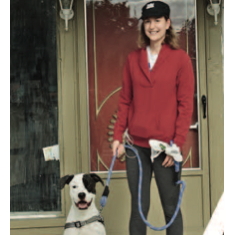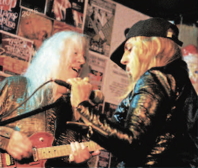Story by: Sara Teller
Photos by: Bernie Laframboise
THE SOFE DISTRICT – A CATCHY NAME FOR ‘SOUTH FERNDALE’ – is made up of various Ferndale businesses,  including Green Daffodil, The Dana Keaton Collection, 700 Livernois Fashion House, Olive’s Bloombox, Christopher George Creations, The Kulick Center, Schramm’s Mead, The Anand Center, Purple Door Tea House, DK Dental, Imax Printing, Joe’s Party Store, Axle Brewery and Margaux & Max. Green Daffodil, a bath-and-body shop, coined the name eight years ago, and it officially took off during the beginning of the construction stage on Livernois earlier this year.
including Green Daffodil, The Dana Keaton Collection, 700 Livernois Fashion House, Olive’s Bloombox, Christopher George Creations, The Kulick Center, Schramm’s Mead, The Anand Center, Purple Door Tea House, DK Dental, Imax Printing, Joe’s Party Store, Axle Brewery and Margaux & Max. Green Daffodil, a bath-and-body shop, coined the name eight years ago, and it officially took off during the beginning of the construction stage on Livernois earlier this year.
“We wanted to give this area its own identity because of the rebirth of the Avenue of Fashion in Detroit,” said Dana Keaton. “It is another enclave for eclectic business in keeping with the Ferndale vibe. It’s funky, eclectic,  and diverse. We want the SoFe District to be the new hot thing!”
and diverse. We want the SoFe District to be the new hot thing!”
Keaton’s business, The Dana Keaton Collection, was established in 2000 and operates as a retail space, an education center, and a place to hold events. Keaton has been in the fashion business all her life. “I sell one-of-a-kind clothing and accessories,” she said. “No two items are alike.”
Keaton is well-known for her award-winning youth fashion programs, and has taught al various schools and centers all over the Detroit metropolitan area. She started The Fashion Atelier, which provides a wide variety of classes to residents. Current classes include Sewing 101, Fashion Illustration, Alterations, Jewelry Design, Modeling, Painting, Drawing, and others. ”You can learn how to design your own skirts, handbags, or yoga pants,” she said. “And yes, men can take the classes, also!”
RECENTLY, A MEETING WAS HELD REGARDING THE SOFE DISTRICT AT FERNDALE’S CITY HALL. ‘This meeting was with the County of Oakland and Ferndale. There were representatives from the County, Ferndale Chamber of Commerce, The DDA, and myself who represented the SoFe District,” Dana explained. She said its purpose ·was to spearhead the annual upcoming Small Business Saturday events. I wanted to be there to make sure the SoFe District was included.”
The group discussed what will take place on Small Business Saturday in November and how the SoFe District will be involved, plans for marketing and promotion, and what can be done to help generate business for the District. Those who were present on behalf of SoFe wanted to ensure this area of Ferndale received just as much attention as any other. “Our concerns were well-received, and they assured us they will include us in all upcoming events held in Ferndale,” Keaton said. ‘We are going to hold them to this!”
The City of Ferndale has also rolled out a series of “SoFe Strolls” in an effort to generate some publicity for the area. During these strolls, customers can stop by the places of business to receive special offers and participate in activities. “The City provided advertising materials for the first event,” Keaton explained. “The businesses of the SoFe District also use the Strolls as a way to help promote our other businesses in the area.”
According to Keaton, internal changes within the City offices have caused the owners lo take up the initiative themselves. ·we do plan to promote the dates ourselves to continue to drive business to our area,” she said, adding, ‘The Livernois businesses are hoping everyone will come to the new SoFe District and ‘Shop Small.'”
The final Strolls will take place on Saturday, October 13, 2018, 10:00 AM – 6:00 PM, and on Small Business Saturday, November 24, 2018, 10:00 AM – 6:00 PM. Green Daffodil will be having a Holiday Artist Markel, Saturday, November 3, 2018 10:00 AM- 5:00 PM, and Keaton will be hosting the Tres Chic Runway Fashion Show from 6:00 PM to 8:00 PM on Small Business Saturday at 700 Livernois Ave.



 what we could do as a two-piece with pre-recorded music and props and character sketches. All performed live. About a year later, my dear friend in the group, Rick Maertens was diagnosed with bone cancer. So we retired Fugitive Poetry. I think our last performance was Spring of 1986, in Windsor. Rick and I were living together at this time and his fiance and myself, along with Southeast Hospice, we all took care of him.
what we could do as a two-piece with pre-recorded music and props and character sketches. All performed live. About a year later, my dear friend in the group, Rick Maertens was diagnosed with bone cancer. So we retired Fugitive Poetry. I think our last performance was Spring of 1986, in Windsor. Rick and I were living together at this time and his fiance and myself, along with Southeast Hospice, we all took care of him.

 believers, according to RVC founding pastor Jim Poole. For the next twelve years, the church expanded and began meeting in several different locations across town. “The pastor at the time was also the Superintendent of Ferndale Schools,” Poole said. “They met for a while all along the 9 Mile corridor.”
believers, according to RVC founding pastor Jim Poole. For the next twelve years, the church expanded and began meeting in several different locations across town. “The pastor at the time was also the Superintendent of Ferndale Schools,” Poole said. “They met for a while all along the 9 Mile corridor.” Schools, the Chamber of Commerce, and the City of Ferndale, as well as its community network groups and those who have oversight responsibilities. “They submitted letters and videos,” Poole said. “The Mayor tagged us in a Facebook post.”
Schools, the Chamber of Commerce, and the City of Ferndale, as well as its community network groups and those who have oversight responsibilities. “They submitted letters and videos,” Poole said. “The Mayor tagged us in a Facebook post.” marriage.” Of the Ethiopia trip, she said, “I never thought I’d have the opportunity, and I was skeptical at first, then finally said I would do it. I’ve never regretted it. It was the best experience.”
marriage.” Of the Ethiopia trip, she said, “I never thought I’d have the opportunity, and I was skeptical at first, then finally said I would do it. I’ve never regretted it. It was the best experience.”

 previous film, Nothin’ But Music, at Found Sound last month, complete with an in-store DVD signing and acoustic performances from some of the musicians prominently featured, including local icons Benny Jet, Howard Glazer and Nate Jones.
previous film, Nothin’ But Music, at Found Sound last month, complete with an in-store DVD signing and acoustic performances from some of the musicians prominently featured, including local icons Benny Jet, Howard Glazer and Nate Jones. MC5 manager jazz-artist/poet John Sinclair and legendary local blues musician Billy Davis. “(Documentary filmmaking) becomes a way of expanding our world and continually exploring and learning about people.”
MC5 manager jazz-artist/poet John Sinclair and legendary local blues musician Billy Davis. “(Documentary filmmaking) becomes a way of expanding our world and continually exploring and learning about people.” Hagopian and Harabadian consider the last eight years of work to be revelatory -informing their own approach and work ethic, but also opening their eyes to the vastly deep well of talent residing right here in southeast Michigan.
Hagopian and Harabadian consider the last eight years of work to be revelatory -informing their own approach and work ethic, but also opening their eyes to the vastly deep well of talent residing right here in southeast Michigan.
 been busy working out the logistics and soliciting feedback from area residents. So far, they’ve secured help from Detroit’s architectural firm Hamilton Anderson, the Community Skatepark Advisory Committee, and the Tony Hawk Foundation, and a few changes have been made along the way.
been busy working out the logistics and soliciting feedback from area residents. So far, they’ve secured help from Detroit’s architectural firm Hamilton Anderson, the Community Skatepark Advisory Committee, and the Tony Hawk Foundation, and a few changes have been made along the way.
